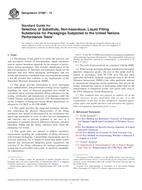Wir benötigen Ihre Einwilligung zur Verwendung der einzelnen Daten, damit Sie unter anderem Informationen zu Ihren Interessen einsehen können. Klicken Sie auf "OK", um Ihre Zustimmung zu erteilen.
ASTM D7887-13
Standard Guide for Selection of Substitute, Non-hazardous, Liquid Filling Substances for Packagings Subjected to the United Nations Performance Tests
Automatische name übersetzung:
Standard-Leitfaden für die Auswahl von Ersatz, nicht gefährliche, Liquid Filling Stoffe für Verpackungen zu den Performance-Tests der Vereinten Nationen unterworfen
NORM herausgegeben am 1.10.2013
Informationen über die Norm:
Bezeichnung normen: ASTM D7887-13
Anmerkung: UNGÜLTIG
Ausgabedatum normen: 1.10.2013
SKU: NS-39236
Zahl der Seiten: 5
Gewicht ca.: 15 g (0.03 Pfund)
Land: Amerikanische technische Norm
Kategorie: Technische Normen ASTM
Kategorie - ähnliche Normen:
Product life-cyclesProtection against dangerous goodsPackaging materials and accessories
Die Annotation des Normtextes ASTM D7887-13 :
Keywords:
dangerous goods package testing, liquid, Newtonian liquid, non-hazardous, non-Newtonian liquid, package testing, substitute fill material, UN testing, ICS Number Code 13.020.60 (Product life-cycles), 13.300 (Protection against dangerous goods), 55.040 (Packaging materials and accessories)
Ergänzende Informationen
| Significance and Use | ||||||||||||||||||
|
5.1 Regulations prescribing the test procedures for hazardous materials packaging allow for the substitution of non-hazardous fill materials for packaging performance tests with certain limitations prescribed and guidance offered [See: 49 CFR 178.602(c)]. This regulatory guidance has proven to be flexible enough, in common industry practice, to produce variations in the selection of fill materials for package performance tests sufficient to cause inconsistent and non-repeatable test results. This variation creates significant problems in product liability, packaging selection and regulatory enforcement in this highly regulated industry. Use of this guide should enhance uniformity in test procedures. 5.2 Consistent and repeatable test results coupled with clear test fill product descriptions will enhance transportation safety by simplifying packaging selection. This will also increase the general level of confidence that package testing, manufacture and use are being guided by sound, generally accepted engineering principles. It also aids in clarifying expectations between the packaging industry and the regulatory authorities. 5.3 The guide will be used by packaging manufacturers, and packaging test labs to create packaging test plans that meet customer needs and conform to the HMR under the widest possible situational circumstances. In addition, for the user of a packaging, certain information about the type and physical characteristics of the material used to test the packaging must be available in the test report and/or notification instruction to allow them to evaluate whether a particular packaging was tested with a substitute material appropriate for the hazardous material to be shipped. |
||||||||||||||||||
| 1. Scope | ||||||||||||||||||
|
1.1 The purpose of this guide is to clarify the selection, use and description criteria of non-hazardous liquid substitutes used to replace hazardous materials for the purpose of performance testing packagings. This includes identification of the physical parameters of substitute non-hazardous liquid test fill materials that may affect packaging performance and test results and should be considered when selecting and describing a test fill material that conforms to the requirements of the Hazardous Materials Regulations (HMR). 1.2 This guide provides information to assist packaging users, manufacturers, and performance testing service suppliers regarding the types of physical properties that should be considered when selecting substitute filling substances for the testing, certification and manufacture of packagings under the United Nations packaging protocols (UN Recommendations on the Transport of Dangerous Goods-Model Regulations) as adopted by US DOT in 49 CFR HMR. 1.3 This guide provides the suggested minimum information concerning the physical characteristics of the filling substances that should be documented in the certification test report and notification to users to allow for test repeatability and analysis, and to provide guidance to the user of a packaging of pertinent physical differences between potential hazardous lading and the filling substance with which the packaging was tested. 1.4 This guide does not purport to address regulatory requirements regarding the compatibility of filling substances with transport packagings. Compatibility requirements must be assessed separately, but it should be noted that under certain national and international dangerous goods regulations, the selection of the filling substances for package performance testing may be prescribed with respect to chemical compatibility requirements. 1.5 The units of measurement are
consistent with the HMR.
1.6 When testing packaging designs intended for hazardous materials (dangerous goods), the user of this guide shall be trained in accordance with 49 CFR §172.700 and other applicable hazardous materials regulations such as the ICAO Technical Instructions, IMDG Code, other applicable national or international dangerous goods regulations that govern the testing, manufacture and use of packagings authorized for the transportation of Dangerous Goods, and carrier rules such as the IATA Dangerous Goods Regulations. 1.7 This standard does not purport to address all of the safety concerns, if any, associated with its use. It is the responsibility of the user of this standard to establish appropriate safety and health practices and determine the applicability of regulatory limitations prior to use. |
||||||||||||||||||
| 2. Referenced Documents | ||||||||||||||||||
|
Empfehlungen:
Aktualisierung der Gesetze
Wollen Sie sich sicher sein, dass Sie nur die gültigen technischen Vorschriften verwenden?
Wir bieten Ihnen Lösungen, damit Sie immer nur die gültigen (aktuellen) legislativen Vorschriften verwenden könnten.
Brauchen Sie mehr Informationen? Sehen Sie sich diese Seite an.




 Cookies
Cookies
